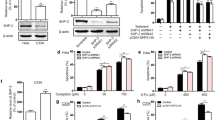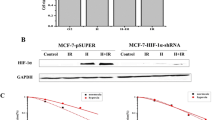Abstract
Mitochondria as the critical powerhouse of eukaryotic cells play important roles in regulating cell survival or cell death. Under numerous stimuli, impaired mitochondria will generate massive reactive oxygen species (ROS) which participate in the regulation of vital signals and could even determine the fate of cancer cells. While the roles of mitochondria in radiation-induced autophagic cell death still need to be elucidated. Human cervical cancer cell line, Hela, was used, and the SOD2 silencing model (SOD2-Ri) was established by gene engineering. Cell viability was detected by methyl thiazolyl tetrazolium (MTT) assays, MitoTracker Green staining was used to detect mitochondrial mass, Western blot was used to detect protein expression, and the level of ROS, autophagy, and mitochondrial membrane potential (MMP) were analyzed by flow cytometry. Ionizing radiation (IR) could induce the increase of MAPLC3-II/MAPLC3-I ratio, Beclin1 expression, and ROS generation but decrease the MMP in a time-dependent manner. After SOD2 silencing, the IR-induced changes of ROS and the MMP were significantly enhanced. Moreover, both the radio sensitivity and autophagy increased in SOD2-Ri cells. Whereas, compared with SOD2-Ri, the opposite results were obtained by NAC, an antioxidant. After the treatment with the inhibitor of mitochondrial electron-transport chain complex II, thenoyltrifluoroacetone (TTFA), the rate of autophagy, ROS, and the total cell death induced by IR increased. In addition, the decrease of MMP was more obvious. However, these results were reversed by cyclosporine A (CsA). IR could induce ROS generation and mitochondrial damage which lead to autophagic cell death in Hela cells.






Similar content being viewed by others
References
Li J, Kang LN, Qiao YL. Review of the cervical cancer disease burden in Mainland China. Asian Pac J Cancer Prev. 2011;12(5):1149–53.
Zhong R, Xu H, Chen G, Zhao G, Gao Y, Liu X, et al. The role of hypoxia-inducible factor-1alpha in radiation-induced autophagic cell death in breast cancer cells. Tumour Biol. 2015.
Liang N, Jia L, Liu Y, Liang B, Kong D, Yan M, et al. ATM pathway is essential for ionizing radiation-induced autophagy. Cell Signal. 2013;25(12):2530–9.
Liang N, Zhong R, Hou X, Zhao G, Ma S, Cheng G, et al. Ataxia-telangiectasia mutated (ATM) participates in the regulation of ionizing radiation-induced cell deathviaMAPK14 in lung cancer H1299 cells. Cell Prolif. 2015;48(5):561–72.
Levine B, Abrams J. p53: the Janus of autophagy? Nat Cell Biol. 2008;10(6):637–9.
Poli V, Camporeale A. STAT3-mediated metabolic reprogramming in cellular transformation and implications for drug resistance. Front Oncol. 2015;5:121.
Azad MB, Chen Y, Gibson SB. Regulation of autophagy by reactive oxygen species (ROS): implications for cancer progression and treatment. Antioxid Redox Signal. 2009;11(4):777–90.
Xie X, Le L, Fan Y, Lv L, Zhang J. Autophagy is induced through the ROS-TP53-DRAM1 pathway in response to mitochondrial protein synthesis inhibition. Autophagy. 2012;8(7):1071–84.
Ravikumar B, Sarkar S, Davies JE, Futter M, Garcia-Arencibia M, Green-Thompson ZW, et al. Regulation of mammalian autophagy in physiology and pathophysiology. Physiol Rev. 2010;90(4):1383–435.
Radi R, Turrens JF, Chang LY, Bush KM, Crapo JD, Freeman BA. Detection of catalase in rat heart mitochondria. J Biol Chem. 1991;266(32):22028–34.
Heo JM, Rutter J. Ubiquitin-dependent mitochondrial protein degradation. Int J Biochem Cell Biol. 2011;43(10):1422–6.
Armstrong JS. Mitochondria: a target for cancer therapy. Br J Pharmacol. 2006;147(3):239–48.
De Duve C. The lysosome. Sci Am. 1963;208:64–72.
De Duve C, Wattiaux R. Functions of lysosomes. Annu Rev Physiol. 1966;28:435–92.
Azad MB, Chen Y, Henson ES, Cizeau J, McMillan-Ward E, Israels SJ, et al. Hypoxia induces autophagic cell death in apoptosis-competent cells through a mechanism involving BNIP3. Autophagy. 2008;4(2):195–204.
Li L, Chen Y, Gibson SB. Starvation-induced autophagy is regulated by mitochondrial reactive oxygen species leading to AMPK activation. Cell Signal. 2013;25(1):50–65.
Chen Y, McMillan-Ward E, Kong J, Israels SJ, Gibson SB. Oxidative stress induces autophagic cell death independent of apoptosis in transformed and cancer cells. Cell Death Differ. 2008;15(1):171–82.
Chen Y, McMillan-Ward E, Kong J, Israels SJ, Gibson SB. Mitochondrial electron-transport-chain inhibitors of complexes I and II induce autophagic cell death mediated by reactive oxygen species. J Cell Sci. 2007;120(Pt 23):4155–66.
Byun YJ, Kim SK, Kim YM, Chae GT, Jeong SW, Lee SB. Hydrogen peroxide induces autophagic cell death in C6 glioma cells via BNIP3-mediated suppression of the mTOR pathway. Neurosci Lett. 2009;461(2):131–5.
Kobayashi K, Nojiri H, Saita Y, Morikawa D, Ozawa Y, Watanabe K, et al. Mitochondrial superoxide in osteocytes perturbs canalicular networks in the setting of age-related osteoporosis. Sci Rep. 2015;5:9148.
Zhang JG, Tirmenstein MA, Nicholls-Grzemski FA, Fariss MW. Mitochondrial electron transport inhibitors cause lipid peroxidation-dependent and -independent cell death: protective role of antioxidants. Arch Biochem Biophys. 2001;393(1):87–96.
Acknowledgments
This study was supported by NSFC grant (31370837 and 81573082).
Conflicts of interest
None
Author information
Authors and Affiliations
Corresponding authors
Rights and permissions
About this article
Cite this article
Chen, Z., Wang, B., Yu, F. et al. The roles of mitochondria in radiation-induced autophagic cell death in cervical cancer cells. Tumor Biol. 37, 4083–4091 (2016). https://doi.org/10.1007/s13277-015-4190-8
Received:
Accepted:
Published:
Issue Date:
DOI: https://doi.org/10.1007/s13277-015-4190-8




